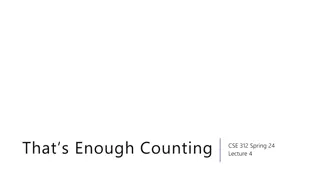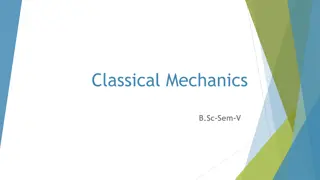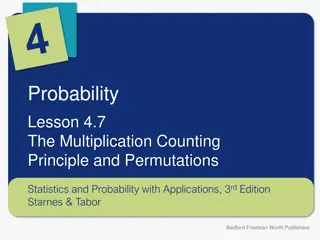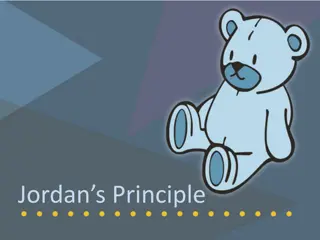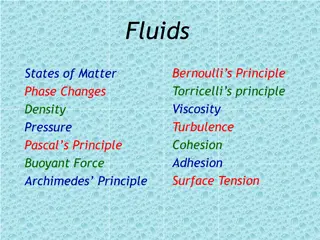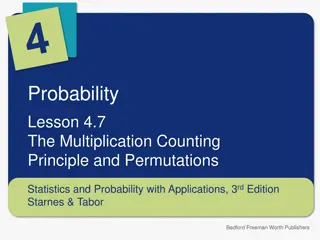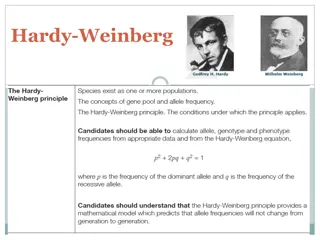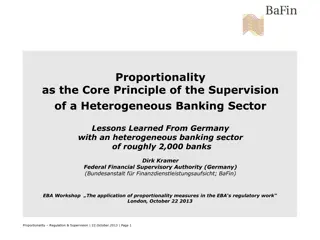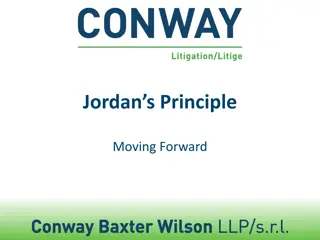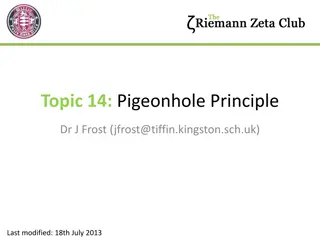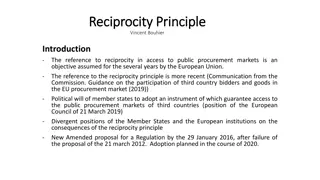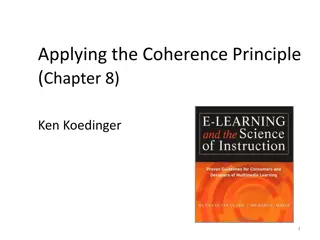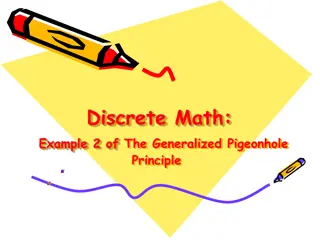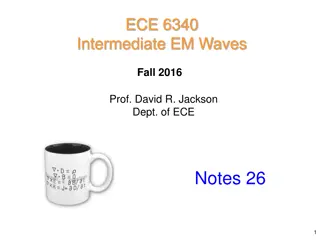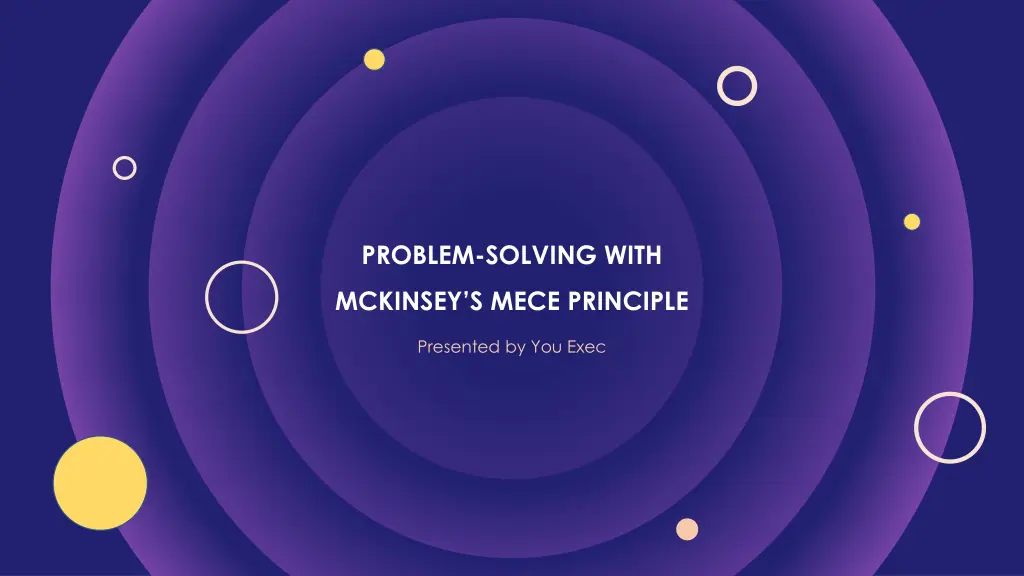
Effective Problem-Solving with MECE Principle
Explore the MECE (Mutually Exclusive, Collectively Exhaustive) principle to enhance problem-solving strategies, as demonstrated through insightful breakdowns and examples. Learn to apply the MECE framework for structured and comprehensive solutions. MECE ensures that each individual falls into only one category while collectively covering all possibilities.
Download Presentation

Please find below an Image/Link to download the presentation.
The content on the website is provided AS IS for your information and personal use only. It may not be sold, licensed, or shared on other websites without obtaining consent from the author. If you encounter any issues during the download, it is possible that the publisher has removed the file from their server.
You are allowed to download the files provided on this website for personal or commercial use, subject to the condition that they are used lawfully. All files are the property of their respective owners.
The content on the website is provided AS IS for your information and personal use only. It may not be sold, licensed, or shared on other websites without obtaining consent from the author.
E N D
Presentation Transcript
PROBLEM-SOLVING WITH MCKINSEY S MECE PRINCIPLE Presented by You Exec
MECE METHOD M MUTUALLY E C COLLECTIVELY E EXCLUSIVE EXHAUSTIVE No one individual can appear in more than one category All categories combined includes all individuals (ex: no individuals are excluded)
MECE DEFINITION MUTUALLY EXCLUSIVE COLLECTIVELY EXHAUSTIVE Not Exhaustive Idea 1 Idea 2 Not Exclusive Idea 1 Idea 2 Exhaustive Idea 1 Idea 2 Exclusive Idea 1 Idea 2 Idea 3
Mutually Exclusive Not Mutually Exclusive MUTUALLY EXCLUSIVE Identifying blocks of data related to each other that do not overlap Collectively Exhaustive Not Collectively Exhaustive COLLECTIVELY EXHAUSTIVE Group 1 *not studied Group 1 Group 2 Group 2 All blocks of data when summed together address the entirety of the problem at hand Group 4 Group 3 Group 4 Group 3
MECE VS. NON-MECE An example for a MECE breakdown is dividing the population into subsets of age: 0 50 100 A group of people below 50 years and another group of 50 years and Group 1 Group 2 Age above is MECE. No person can be in both groups mutually exclusive but every person is in either one of them collectively exhaustive. 0 50 100 A group of people below 50 years and another group of people from 40 to 70 years is not MECE, as people from 40 to 50 years belong to Age Group 1 Group 2 both groups they are not mutually exclusive and people above 70 are in neither one of the groups they are not collectively exhaustive. Not Exclusive Not Exhaustive
EXAMPLE: NORTH AMERICAN CELL PHONE MARKET MECE BREAK DOWN NON-MECE BREAK DOWN Female, male or non-binary GENDER Female Consumer, business or government TYPE Business Age 35+ 0-18, 19-34, 35+ AGE
COLLECTIVELY EXHAUSTIVE DEFINITION B C C A A D COLLECTIVELY EXHAUSTIVE NOT COLLECTIVELY EXHAUSTIVE
PROBLEM Breakdown with MECE SUBPROBLEM Can you take a physical action to solve this subproblem? GO SOLVE IT! NO YES
TWO-PART MECE FRAMEWORK EXAMPLE Internal External ECONOMIC BARRIERS Short-term Long-term Raw Materials Equipment Labor Other Capital Economic Non-economic Quantitative Qualitative VS Direct Indirect NON-ECONOMIC BARRIERS Supply-side Demand-side Knowledge & Expertise Brand Name Distribution channels Upside Downside Benefits Costs
MECE EXAMPLE: You may have a customer list segmented according to these age brackets: CUSTOMER AGE BRACKETS With these categories you have covered all possible ages of customers 0-15 16-30 76+ AGE No one can appear in more than one category 61-75 31-45 46-60 15 years are represented in each category. This makes them easily comparable
MECE EXAMPLE: CUSTOMER AGE BRACKETS MUTUALLY EXCLUSIVE COLLECTIVELY EXHAUSTIVE No one individual can appear in more than one category The age grouping taken as a whole cover the entire population 0-15 16-30 31-45 46-60 61-75 76+
MECE EXAMPLE: PROFITABILITY FRAMEWORK Price/Unit Revenue Units Sold PROFIT Cost/Unit Cost/Unit Cost Units Sold Units Sold
STEPS OF PROFITABILITY FRAMEWORK Valuable costs can be further broken down into volume and cost per unit Then, revenues are broken down into volume and price per unit (PPU) STEP 1 STEP 3 First, profits are broken down into revenues and costs. Costs are broken down into fixed costs and valuable costs STEP 2 STEP 4
Sub Condition 1-A CONDITION 1 Sub Condition 1-B Sub Condition 1-C Sub Condition 2-A HYPOTHESIS IS TRUE IF CONDITION 2 Sub Condition 2-B Sub Condition 2-C Sub Condition 3-A CONDITION 3 Sub Condition 3-B Sub Condition 3-C
HOW SHOULD WE MAKE THE COMPANY MORE PROFITABLE? THE STRUCTURE IS MECE By increasing our By decreasing our If a node is in one branch of the map, it isn t in another and the REVENUES COSTS map is collectively exhaustive. By increasing our revenues By Increasing our revenues By decreasing our By decreasing our from returning clients from new clients fixed costs variable costs THE ANSWERS ARE ICE: One being true doesn t preclude other to be also true. Rather, they are independent (I) + collectively exhaustive (CE)


